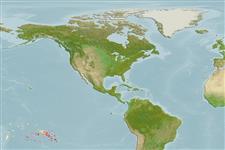Classification / Names
Populärnamn | synonymer | Catalog of Fishes(Släkte, Arter) | ITIS | CoL | WoRMS | Cloffa
>
Tetraodontiformes (Puffers and filefishes) >
Monacanthidae (Filefishes)
Etymology: Cantherhines: Greek, kanthos = the outer or inner corner of the eye, where the lids meet, 1646 + Greek, rhinos = nose (Ref. 45335); longicaudus: Named for its long caudal fin..
More on authors: Hutchins & Randall.
Environment: milieu / climate zone / depth range / distribution range
Ekologi
marina bottenlevande; djupintervall 18 - 21 m (Ref. 6220). Tropical
Eastern Central Pacific: Tahiti, French Polynesia, Pitcairn and Cook Islands.
Size / Vikt / Age
Maturity: Lm ? range ? - ? cm
Max length : 13.2 cm SL (female)
Feeds on algae and benthic invertebrates (Ref. 89972).
Life cycle and mating behavior
Maturities | Reproduktion | Spawnings | Egg(s) | Fecundities | Larver
Hutchins, J.B. and J.E. Randall, 1982. Cantherhines longicaudus, a new filefish from Oceania, with a review of the species of the C. fronticinctus complex. Pac. Sci. 36(2):175-185. (Ref. 6220)
IUCN Red List Status (Ref. 130435)
Threat to humans
Harmless
Human uses
Verktyg
Special reports
Download XML
Internet-källor
Estimates based on models
Preferred temperature (Ref.
123201): 25.5 - 29, mean 27.8 °C (based on 146 cells).
Phylogenetic diversity index (Ref.
82804): PD
50 = 0.5002 [Uniqueness, from 0.5 = low to 2.0 = high].
Bayesian length-weight: a=0.01995 (0.00943 - 0.04220), b=2.93 (2.75 - 3.11), in cm total length, based on LWR estimates for this (Sub)family-body shape (Ref.
93245).
Trofisk nivå (Ref.
69278): 3.0 ±0.2 se; based on size and trophs of closest relatives
Resiliens (Ref.
120179): Hög, lägsta populationsfördubblingstid mindre än 15 månader (Preliminary K or Fecundity.).
Fishing Vulnerability (Ref.
59153): Low vulnerability (10 of 100).
Nutrients (Ref.
124155): Calcium = 154 [52, 578] mg/100g; Iron = 1.98 [0.66, 5.72] mg/100g; Protein = 17.2 [14.9, 19.4] %; Omega3 = 0.134 [0.054, 0.339] g/100g; Selenium = 53.2 [17.0, 165.0] μg/100g; VitaminA = 21.7 [6.7, 71.3] μg/100g; Zinc = 2.32 [1.04, 4.55] mg/100g (wet weight);
